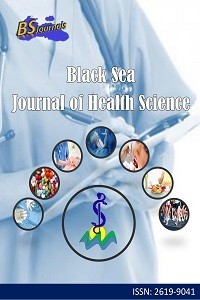Multi-Perspective Investigation of Paroxysmal Nonepileptic Events Retrospectively
Multi-Perspective Investigation of Paroxysmal Nonepileptic Events Retrospectively
Non-epileptic paroxysmal events, psycogenic seizure,
___
- 1.Visser AM, Jaddoe VW, Arends LR, Tiemeier H, Hofman A, Moll HA. 2010. Paroxysmal disorders in infancy and their risk factors in a population-based cohort: the Generation R Study. Dev Med Child Neurol,52:1014-20.2. Yalnızoglu D, Alan S, Turanlı G, Topçu M. 2009. P137 Nonepileptiform paroxysmal events in childhood. European Paediatric Neurology Society. Eur J Paediatr Neurol,13:562. 3. Montenegro MA, Sproule D, Mandel A, Cappell J, Chiriboga CA, Jacob S. 2008. The frequency of non-epileptic spells in children:results of video-EEG monitoring in a tertiary care center. Seizure,17:583-7.4. Kutluay E, Selwa L, Minecan D, Edwards J, Beydoun A. 2010. Nonepileptic paroxysmal events in a pediatric population. Epilepsy Behav, 17:272-5.5. Bowman ES. 2000. Nonepileptic Seizures. Curr Treat Options Neurol, 2:559-70.6. Nežádal T, Hovorka J, Herman E, Němcová I, Bajaček M, Stichová E. 2011. Psychogenic non-epileptic seizures: our video-EEG experience. Neurol Res, 33:694-700.7. Mackay M. 2005. Fits, faints and funny turns in children. Aust Fam Physician, 34:1003-8.8. Akçam M. 2002. Breath holding spells. Klinik Pediatri Dergisi,1:99-102 (in Turkish).9. Gençgönül H, Cin Ş, Akar N, Deda G. 2002. İron and zinc levels in breath-holding spells. J Ankara Med School, 24:99-104 (in Turkish).10. Şakru A, Genel F, Atlıhan F, Serdaroğlu E. 2000. Prevelance of iron deficiency anemia in 6 month - 15 years children. Ege Pediatri Bülteni,7: 175-80 (in Turkish). 11. Mocan H, Yildiran A, Orhan F, Erduran E. 1999. Breath holding spells in 91 children and response to treatment with iron. Arch Dis Child, 81:261-2.12. Wichaidit BT, Østergaard JR, Rask CU. 2015. Diagnostic practice of psychogenic nonepileptic seizures (PNES) in the pediatric setting. Epilepsia, 56:58-65.13. Benbadis SR, Chichkova R. 2006. Psychogenic pseudosyncope: an underestimated and provable diagnosis. Epilepsy Behav, 9:106-10.14. Asadi-Pooya AA, Sperling MR. 2015. Epidemiology of psychogenic nonepileptic seizures. Epilepsy Behav, 46:60-5.15. Ercan ES, Varan A, VeznedaroGlu B. 2003. Associated features of conversion disorder in Turkish adolescents. Pediatr Int, 45:150-5.16. Bhatia MS, Sapra S. 2005. Pseudoseizures in children: a profile of 50 cases. Clin Pediatr (Phila), 44:617-21.17. Tinuper P, Provini F, Bisulli F, Vignatelli L, Plazzi G, Vetrugno R. 2007. Movement disorders in sleep: guidelines for differentiating epileptic from non-epileptic motor phenomena arising from sleep. Sleep Med Rev, 11:255-67.18. Ristić AJ, Petrović I, Vojvodić N, Janković S, Sokić D. 2000. [Phenomenology and psychiatric origins of psychogenic non-epileptic seizures]. Srp Arh Celok Lek,132:22-7 (in Serbian). 19. Syed TU, LaFrance WC Jr, Kahriman ES, Hasan SN, Rajasekaran V, Gulati D. 2011. Can semiology predict psychogenic nonepileptic seizures? A prospective study. Ann Neurol, 69:997-1004.
- Yayın Aralığı: Yılda 4 Sayı
- Başlangıç: 2018
- Yayıncı: Cem TIRINK
Mohamad Hesam SHAHRAJABİAN, Wenli SUN, Qi CHENG
Multi-Perspective Investigation of Paroxysmal Nonepileptic Events Retrospectively
Hatice MUTLU ALBAYRAK, Haydar Ali TAŞDEMİR
Implant Surgery-Characterized by Extensive Ecchymosis: A Case Report
Musa SADİKHOV, Özlem GERGİNOK, Sevil KAHRAMAN
Short-term Forecasts of the COVID-19 Epidemic in Turkey: March 16–28, 2020
